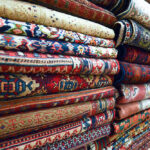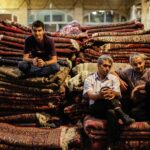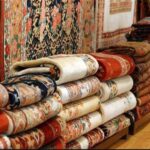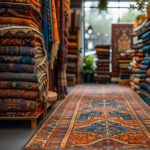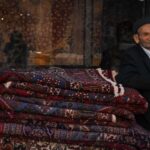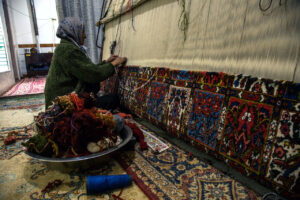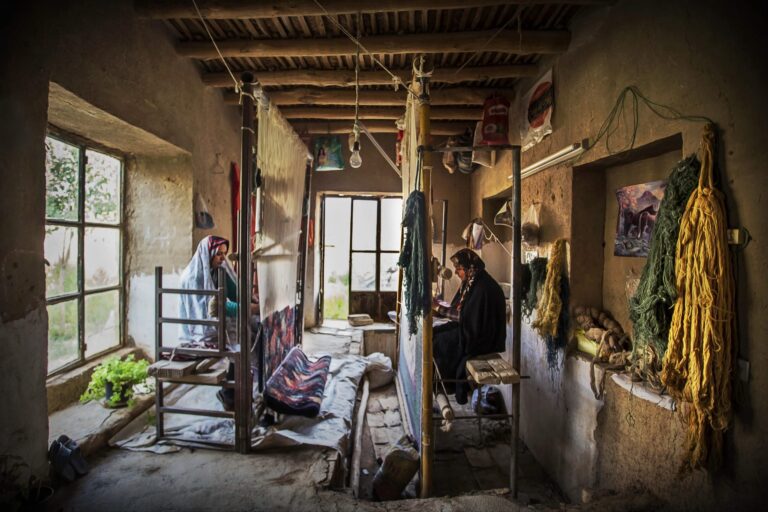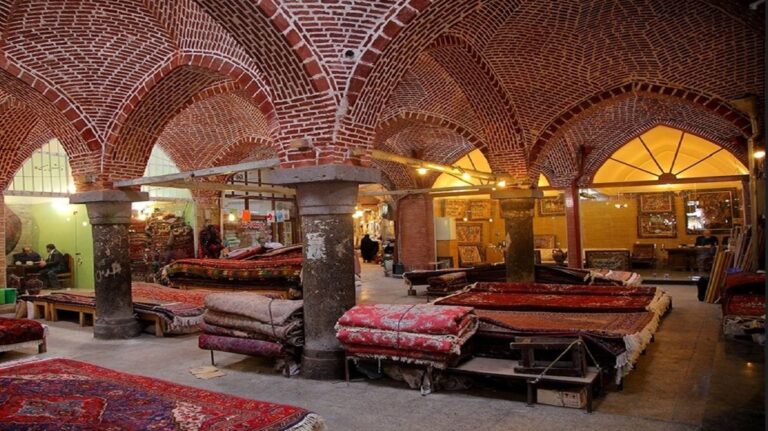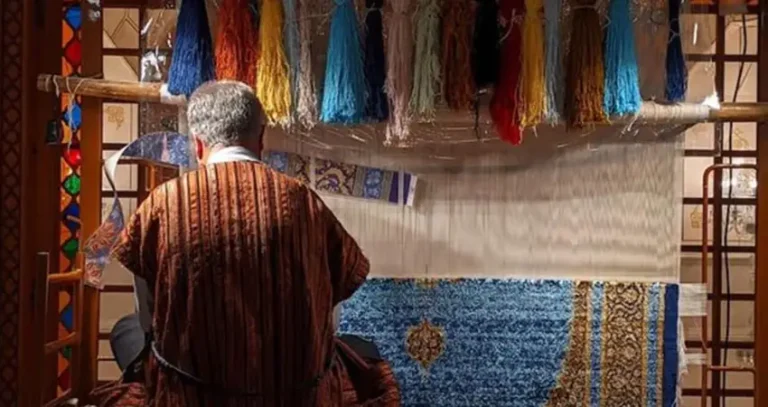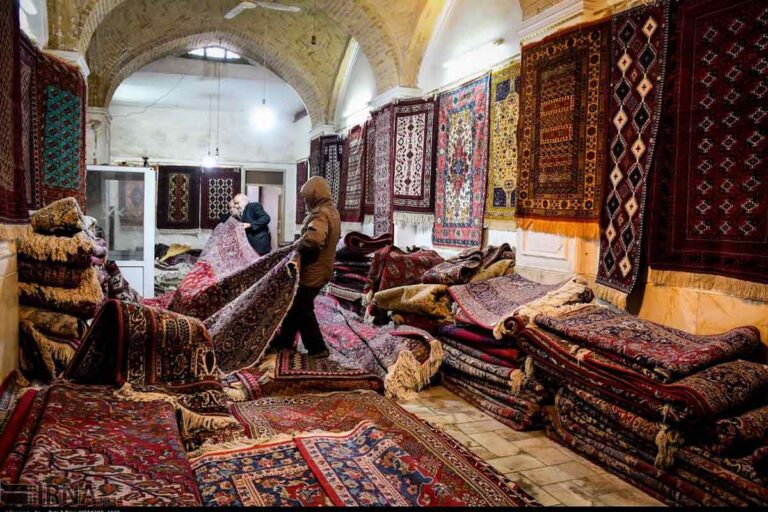Regional Design Characteristics in Persian Carpets and Rugs
Knotting Techniques of Persian Rugs by Region
Color is far more than a mere visual element in Persian rug design—it’s a language that conveys history, emotion, and cultural identity. Across Iran’s diverse regions, the distinctive color schemes of rugs tell stories of local traditions, beliefs, and environmental influences. In this post, we explore how different regions use color palettes in their rugs and what these hues symbolize culturally, delving into the artistry of cities such as Tabriz, Kashan, Nain, Qom, Isfahan, Kerman, Ardabil, Qazvin, Shiraz, Yazd, and Sanandaj.
Tabriz: Bold Hues and Timeless Narratives
Color Characteristics:
Tabriz rugs are famous for their bold, vibrant hues. Deep reds, rich blues, and warm earth tones dominate the designs, often punctuated by contrasting accents.
Cultural Significance:
-
Deep Red: Symbolizes passion, vitality, and the enduring spirit of the region.
-
Rich Blue: Represents depth, stability, and the vastness of Persian history.
-
Earth Tones: Ground the design in nature, connecting the artistry with the land.
The interplay of these colors in Tabriz rugs creates a striking visual narrative and encapsulates the resilience and dynamic heritage of the region.
Kashan: Subtle Pastels and Floral Elegance
Color Characteristics:
Kashan rugs often feature a softer, refined palette. Gentle pastels, muted greens, and soft pinks dominate the designs, evoking a serene and delicate aesthetic.
Cultural Significance:
-
Pastel Hues: Reflect tranquil gardens and refined architecture, symbolizing purity and beauty.
-
Muted Greens: Signify growth, renewal, and a connection with nature.
-
Soft Pinks: Convey grace and poetic elegance, mirroring the region’s artistic legacy.
The refined colors of Kashan rugs serve as a visual ode to nature’s subtle beauty and artistic tradition.
Nain: Minimalism in Muted Tones
Color Characteristics:
Nain rugs are distinguished by their minimalist use of color. They typically employ a restrained palette of muted neutrals—such as soft beiges, creams, and light grays—with occasional subtle highlights.
Cultural Significance:
-
Neutral Tones: Emphasize simplicity and balance, reflecting an appreciation for understated elegance.
-
Subtle Accents: Every hint of color is used with intention, symbolizing refined taste and attention to detail.
The restrained color schemes of Nain rugs mirror a philosophical approach where less is more, underlining a deep respect for quiet sophistication.
Qom: Spiritual Depth Through Vibrant Contrasts
Color Characteristics:
Rugs from Qom are known for their striking contrasts and vivid, spiritually resonant colors. Deep blues, emerald greens, and luminous gold accents are prevalent.
Cultural Significance:
-
Deep Blues and Greens: Represent divine wisdom and the eternal nature of spirituality.
-
Gold Accents: Symbolize enlightenment and the divine light that guides the path to truth.
-
Bold Contrasts: Remind viewers of the interplay between the material and the metaphysical.
In Qom rugs, each hue is chosen with spiritual intent, turning the design into a meditative tapestry that bridges the earthly with the sacred.
Isfahan: A Symphony of Color and Ornamentation
Color Characteristics:
Isfahan rugs are celebrated for their complex layering of colors—ranging from vibrant reds and blues to soft ivories and greens. This diverse palette creates a rich, dynamic visual experience.
Cultural Significance:
-
Vibrant Reds and Blues: Evoke the grandeur of Isfahan’s imperial past and its thriving artistic spirit.
-
Subtle Ivories and Greens: Offer balance, symbolizing harmony and natural beauty.
-
Layering of Hues: Reflects the multifaceted history and cultural synthesis of the city.
Isfahan rugs exemplify how a masterful use of color can create both visual impact and deep emotional resonance.
Kerman: Exotic Palettes and Cross-Cultural Influences
Color Characteristics:
Kerman rugs often feature eclectic and exotic color combinations. Bright oranges, deep purples, and lush greens are common, creating bold contrasts and a dramatic visual statement.
Cultural Significance:
-
Vivid Oranges and Purples: Suggest opulence and mystery, reflective of Kerman’s historical role along vibrant trade routes.
-
Lush Greens: Connect the designs to local landscapes and agricultural heritage.
-
Dynamic Contrasts: Represent the fusion of diverse cultural influences, highlighting a dialogue between Eastern and Western traditions.
Kerman rugs embody a spirit of adventure and cultural exchange, making each piece a vibrant storyteller of regional diversity.
Ardabil: Warm Earth Tones and Nature-Inspired Hues
Color Characteristics:
Ardabil rugs are known for their warm, earthy palettes. They often incorporate shades of brown, beige, and muted reds that mimic the natural landscapes of the region.
Cultural Significance:
-
Earthy Browns and Beiges: Reflect the natural environment and the region’s deep connection to the land.
-
Muted Reds: Convey a sense of history and resilience, linking the rug’s design to longstanding traditions.
-
Organic Inspiration: The overall palette emphasizes harmony with nature and the beauty of simplicity.
Ardabil rugs are a celebration of nature’s understated beauty, capturing the spirit of the local landscape.
Qazvin: Regal Hues and Historical Richness
Color Characteristics:
Qazvin rugs often feature a palette that exudes elegance and regality. Deep jewel tones, combined with contrasting lighter shades, create a dramatic yet balanced look.
Cultural Significance:
-
Jewel Tones: Such as sapphire blue and ruby red, symbolize luxury and the city’s royal heritage.
-
Contrasting Light Shades: Add depth and enhance the intricacy of the designs, reflecting historical narratives of power and refinement.
-
Artistic Innovation: The blend of colors in Qazvin rugs underscores the region’s legacy of innovation and artistry.
Qazvin’s color schemes are a testament to its storied past and its enduring influence in Persian textile art.
Shiraz: Poetic Warmth and Bold Expression
Color Characteristics:
Shiraz rugs are imbued with a warm, poetic palette that often includes bold reds, oranges, and deep maroons, balanced by softer, complementary tones.
Cultural Significance:
-
Bold Reds and Oranges: Evoke passion, energy, and the vibrant cultural tapestry of Shiraz.
-
Deep Maroons: Suggest a richness and depth that echo the city’s storied literary and artistic traditions.
-
Balanced Accents: The interplay of warm and soft hues creates a dynamic yet harmonious composition, reflective of poetic expression.
Shiraz rugs capture the essence of the city’s dramatic and artistic soul, making them visual manifestations of cultural poetry.
Yazd: Desert-Inspired Neutrals and Striking Accents
Color Characteristics:
Yazd rugs draw inspiration from the desert landscapes that surround the city. They typically feature neutral tones accented with vibrant bursts of color.
Cultural Significance:
-
Desert Neutrals: Such as sandy beiges and warm creams, reflect the arid beauty of the region.
-
Striking Accents: Bold hues, often in blues or reds, serve as visual oases, evoking the rare beauty found in desert blooms.
-
Subtle Contrasts: Emphasize the interplay between harsh environments and refined artistry.
The color palette of Yazd rugs is a tribute to the resilience and hidden beauty of desert life.
Sanandaj: Ethnic Richness and Dynamic Contrasts
Color Characteristics:
Sanandaj rugs, influenced by rich Kurdish heritage, feature dynamic and vibrant color schemes. They often incorporate striking contrasts that make each design a bold statement.
Cultural Significance:
-
Vibrant Primary Colors: Such as deep reds, bright blues, and energetic greens, reflect the cultural richness and vitality of the Kurdish people.
-
Bold Contrasts: Enhance the narrative quality of the designs, symbolizing the diverse and spirited cultural identity of the region.
-
Expressive Patterns: The vivid color interplay is used to tell stories of local folklore, history, and tradition.
Sanandaj rugs are celebrated for their expressive power and are a vibrant testament to ethnic identity and creative resilience.
Bringing It All Together
Across Iran, the color palettes of regional rugs are more than mere decoration—they are symbolic narratives woven into every knot and pattern. From the bold and dynamic hues of Tabriz to the soft, refined pastels of Kashan; the minimalist neutrals of Nain; the spiritually charged contrasts of Qom; the layered complexity of Isfahan; the exotic vibrancy of Kerman; the earthy inspiration of Ardabil; the regal elegance of Qazvin; the poetic warmth of Shiraz; the desert-inspired balance of Yazd; and the ethnic richness of Sanandaj—each rug is a vibrant reflection of its locale.
By exploring these distinctive color schemes, we gain a deeper appreciation for how regional identity, cultural values, and historical experiences shape the art of Persian rug making. These textiles are not only functional masterpieces but also visual histories, with each hue chosen to express a story, a belief, or a tradition that has been passed down through generations.



